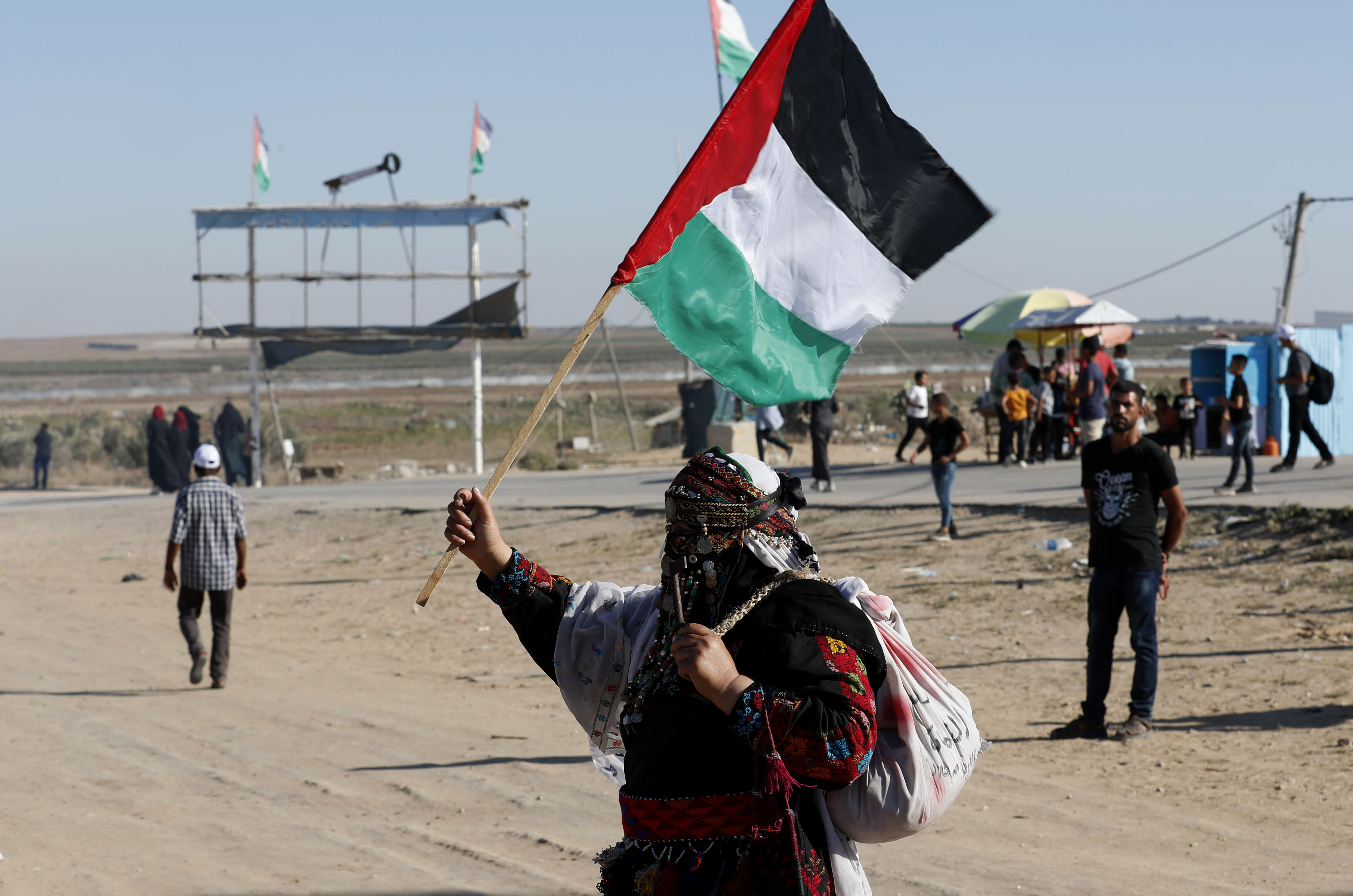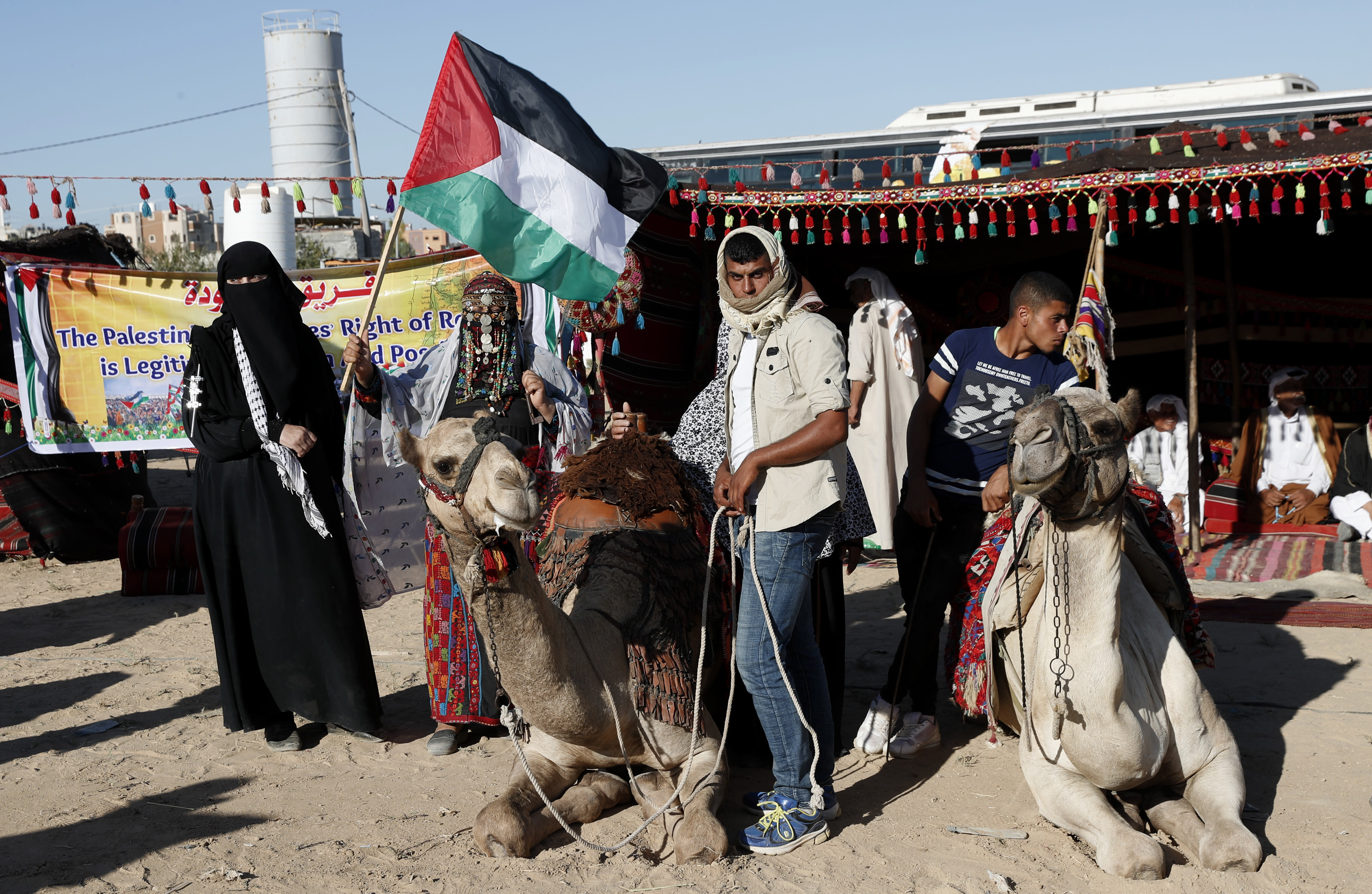With little to show, Gazans question mass border protests



With little to show, Gazans question mass border protests
Associated Press•October 11, 2019
Gaza Protests Backlash

In this Sept. 25, 2019 photo, a Palestinian woman waves a national flag during a alternative protest organized by activist Ahmed Abu Artima near the separation fence between the Gaza Strip and Israel, east of Gaza City. Gaza’s Hamas rulers are facing a rare and growing chorus of criticism, with little to show after 18 months of mass protests along the Israeli border organized by the Palestinian militant group. Gazans are increasingly questioning the high number of casualties and lack of success in lifting the Israeli blockade. Against this backdrop, Artima has launched his own peaceful version of the protest. (AP Photo/Adel Hana)

In this Sept. 25, 2019 photo, Palestinians attend an alternative protest organized by activist Ahmed Abu Artima near the separation fence between the Gaza Strip and Israel, east of Gaza City. Gaza’s Hamas rulers are facing a rare and growing chorus of criticism, with little to show after 18 months of mass protests along the Israeli border organized by the Palestinian militant group. Gazans are increasingly questioning the high number of casualties and lack of success in lifting the Israeli blockade. Against this backdrop, Artima has launched his own peaceful version of the protest. (AP Photo/Adel Hana)

In this Sept. 25, 2019 photo, Palestinian activist Ahmed Abu Artima holds his daughter during an alternative protest he organized near the separation fence between the Gaza Strip and Israel, east of Gaza City. Gaza’s Hamas rulers are facing a rare and growing chorus of criticism, with little to show after 18 months of mass protests along the Israeli border organized by the Palestinian militant group. Gazans are increasingly questioning the high number of casualties and lack of success in lifting the Israeli blockade. Against this backdrop, Artima has launched his own peaceful version of the protest. (AP Photo/Adel Hana)
GAZA CITY, Gaza Strip (AP) — Ahmed Abu Artima was one of the founders of the "Great March of Return," the weekly protests along Gaza's frontier with Israel meant to draw attention to the plight of the territory's 2 million people. But these days, he mostly avoids the demonstrations.
He is among a growing number of Gazans who believe the protests have lost their way. With little to show from 18 months of demonstrations beyond the hundreds of people killed or wounded by Israeli fire, many Gazans are beginning to question and even criticize the Hamas-led protests, a rarity in a territory where dissent is barely tolerated by the ruling Islamic militant group.
For several months now, Abu Artima has organized his own alternative protest. On a recent Wednesday, dozens of Palestinians gathered near the separation fence between Israel and Gaza, performing traditional dances and ballads between poem recitals and speeches by local community leaders. Children gathered around two camels decorated with embroidered saddles.
Abu Artima's eyes sparkled as he watched. This is the kind of demonstration he envisioned when he and other young grassroots activists came up with the idea of building mass encampments along the fortified frontier. He calls it a protest that "tries to deliver our message as safely as possible."
Held every two weeks, these events are in dramatic contrast to the main Friday protests.
Directed by a committee comprised of Hamas and other Gaza militant groups, the Friday demonstrations are held against a backdrop of black smoke from burning tires. Protesters hurl rocks at Israeli troops, who respond with clouds of tear gas and gunfire. Ambulances scream back and forth, ferrying the wounded to field clinics and hospitals.
When the protests began, Hamas quickly seized upon the popular idea and transformed the quiet gatherings into violent confrontations.
Under its direction, thousands of Palestinians have gathered at five sections of the fence each week, facing off against Israeli forces perched on earth mounds and in sniper positions. The Israeli troops fire live shots, rubber-covered steel pellets and tear gas, in what Israel says is a legitimate tactic to defend against attacks and border infiltrations.
Hamas says the violent protests, which are still attended by a few thousand people every Friday, are meant to force Israel to ease its crippling blockade. But the demonstrations have done little to improve conditions in Gaza, and have come at a high human cost.
The Gaza-based al-Mezan Center for Human Rights says 211 Palestinian protesters, most of them unarmed, have been shot dead during the demonstrations, including 46 under the age of 18. More than 18,000 have been wounded. The Health Ministry says 124 had amputations in lower limbs. One Israeli soldier has also been killed.
With Hamas dedicating this week's protest to "child martyrs," U.N. Humanitarian Coordinator Jamie McGoldrick urged both sides to protect children. "Boys and girls must never be targeted, put at risk or encouraged to participate in violence," he said.
Calling his event "The Return Journeys," Abu Artima says he is focused on his original idea of highlighting the desire of Palestinian refugees and their descendants to return to the lands they fled or were forced from during the 1948 war surrounding Israel's establishment. Some two-thirds of Gaza's population are refugees.
"We want to present a model for the people that we can send our voice by art and national songs," he said. "Our presence here even without direct confrontation is a message of determination."
While the "right of return" was the original message of the demonstrations, Hamas quickly turned the focus to the 12-year-old blockade imposed by Israel and Egypt after the Islamic militant group seized control of Gaza in 2007.
The blockade has devastated Gaza's economy and caused the unemployment rate to skyrocket to over 50%. Israel says the closure is needed to prevent Hamas from arming.
Hamas views the protests as a key form of leverage in getting the closures lifted, so it urges maximum participation. On days before protests, vehicles with loudspeakers mounted on their roofs tour Gaza streets and mosques urging families to head to the fence. On Friday, buses pick up participants from across the strip.
There have also been calls to storm the frontier. In May 2018, as the U.S. was opening its embassy in Jerusalem after relocating it from Tel Aviv, more than 55 Palestinians were killed in a single day as tens of thousands protested amid Hamas calls to cross into Israel.
To prevent what could have been a fourth war in a decade between Hamas and Israel, mediators rushed to contain the protests. Under an unofficial Egyptian-brokered truce, Hamas scaled down the marches in recent months while Qatar delivered cash infusions for Hamas' civil servants and welfare programs. U.N.-sponsored job creation programs were also envisioned.
Hamas scaled back the protests, triggering more accusations that it was acting for its own interests. Critics include scores of people who were shot in the legs . In Gaza's overwhelmed medical system, such cases often end with amputations.
In a video circulated in August, a father scolded his wounded son at a hospital for going to the protests and accused doctors of not providing proper medical care for the teenage boy.
Hamas officials also came under fire after a press photo went viral showing rows of amputees at a Hamas event, each waiting for a $50 welfare payment.
Hamas attempted to portray the event as a celebration of solidarity, but critics said it was humiliating and accused the group of exploiting the wounded men for public relations purposes.
Khalil al-Hayya, a senior Hamas official, said his movement tries to provide allowances for each of those wounded.
"These are our capabilities, what shall we do? Shall we stop the protests?" he asked during a meeting with journalists earlier this month.
He said complaints of lack of proper care and discontent over the protests' usefulness "carry a lot of exaggeration."
One of those critics is Ziad al-Madani, a day laborer who barely scrapes together enough money to provide milk and diapers for his three children. Wounded by a live bullet last February, the 28-year-old ended up having his right leg amputated last month.
He said treatment was unavailable and Israel rejected three requests for him to travel to hospitals in the occupied West Bank for proper care.
"This injury affected my life and now I'm unable to work," he said, sitting with his children on a mattress, his leg still covered in bandages. "I did not get anything from these protests."
Hussam al-Nadi, another young protester shot in the leg last spring, fears a similar fate. A metal ring known as a fixator stabilizes the bone in his right leg. Now, he joins the Wednesday activities organized by Abu Artima.
"This is a festival and a celebration and has no problems like the Friday protests," he said.




It just took them a year and a half to figure out they were being used.
Let us know when Israel even bothers to notice these new peaceful protests. In 18 months they will have just as much success as the Hamas protests; but at least less people will have been shot. (So long as they don't get too close to the barrier) Not that these colorful protests will attract much attention since Gaza has zero tourism due to the Israeli blockade/embargo..
Gaza needs to remove Hamas; but there is no alternative. Anyone that becomes a real threat to Hamas will be killed.
Egypt also borders on Gaza and blockades it. Why don't you bitch about Egypt as well, or is Israel a "special case" with you? As it happens, after the Mavi Marmara incident, the UN declared Israel's blockade to be LEGAL!!! Are you not aware of why it is necessary?